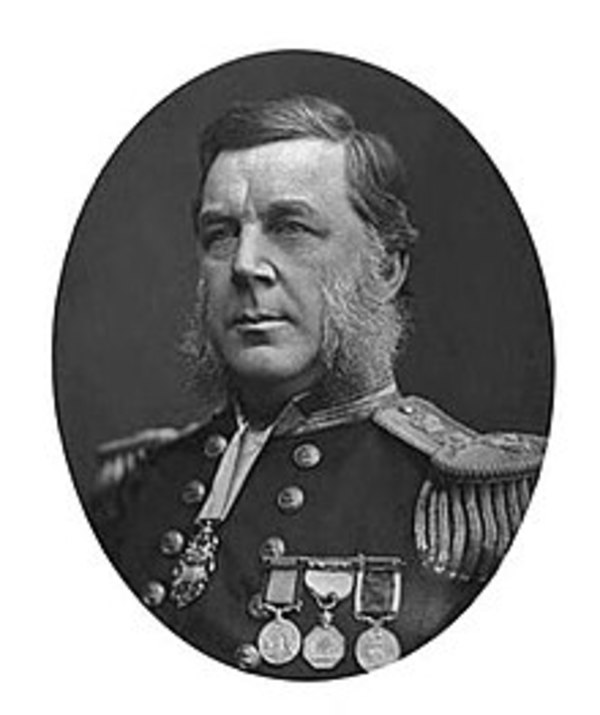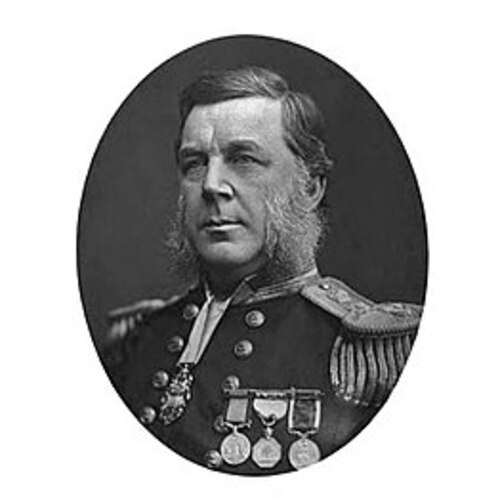
Source: Link
PIM, BEDFORD CLAPPERTON TREVELYAN, naval officer and Arctic explorer; b. 12 June 1826 at Bideford, England, son of Edward Bedford Pim and Sophia Soltau Harrison; m. 3 Oct. 1861 Susanna Locock, and they had two sons; d. 30 Sept. 1886 at Deal, Kent, England.
Bedford Clapperton Trevelyan Pim was educated at the Royal Naval School, New Cross, and entered the Royal Navy in 1842. In 1845 he was appointed to the Herald, commanded by Captain Henry Kellett*, who had been commissioned to prepare Admiralty charts of the Pacific coast of Central America and Lower California. In the summer of 1849 the Herald was called to assist the Plover in the search of the seas north of the Bering Strait for the ships of Sir John Franklin* which had not been heard from since 1845. During the winter of 1849–50 Pim served under Captain Thomas Edward Laws Moore of the Plover which was based in Kotzebue Sound on the west coast of Alaska. From here Pim was ordered to make a journey to Mikhailovsk (Egg Island, Alaska), to question the Inuit of that area concerning Franklin’s lost ships. This trip, although not successful in tracing Franklin, gave Pim valuable experience in travel by dog sledge in the Arctic. The Herald reached England in June 1851 and was paid off; Pim was promoted lieutenant on 6 September.
In the winter of 1851–52 Pim, with official British support, made a journey to St Petersburg, Russia, in an unsuccessful endeavour to promote a search for the Franklin expedition on the north Siberian shore. After his return. to England he sailed, in April 1852, on the Resolute, one of the five ships of the Franklin rescue squadron commanded by Sir Edward Belcher*. On entering Barrow Strait Belcher turned up Wellington Channel, ordering Resolute and Intrepid, the former commanded by Kellett and the latter by Francis Leopold McClintock*, to go west and search the Melville Island region. They were also told to keep a lookout for the rescue ship Investigator, commanded by Robert John LeMesurier McClure*, which had entered the Arctic by Bering Strait and had gone unreported for two years.
On 9 Sept. 1852 Kellett’s party berthed near the Melville Island shore just east of Winter Harbour. Lieutenant George Frederick Mecham* visited the latter place and found a cached record of the Investigator. It stated that after discovering the last link in the northwest passage McClure had become ice-bound for months across Viscount Melville Sound on the north shore of Banks Island. It was too late for help to reach McClure that season, but as the starving crew was likely to desert their ship in early spring in a desperate attempt to reach the mainland, Pim was dispatched with two sledges. The larger man-hauled sledge broke down and Pim crossed the sound to Banks Island with two men, Robert Hoyle and Thomas Bidgood, in the bitter cold of March 1853 with a light dog sledge. It was a daring venture and was only warranted by extreme emergency. The inordinately long time spent on the journey, 28 days for 160 miles, may be explained by inexperience, foul weather, and the fact that McClure had been inexact in giving his position. Pim probably had to follow the shore of Banks Island to find the Investigator’s anchorage which was at Mercy Bay. He accomplished this on 6 April, just in time to avert the desertion of most of the ship’s crew, an action which certainly would have been fatal to all who shared in it.
On their way home, carrying the 63 rescued men, Kellett’s ship and its steam-tender were frozen in and spent the winter in the pack of Barrow Strait, and Belcher’s ships were also ice-bound in Wellington Channel. In the spring of 1854 four ships were abandoned and the crews were taken to England on the North Star commanded by William John Samuel Pullen and on two supply vessels; they arrived in England on 28 September. Kellett naturally expected that he and his men, who had rescued the discoverers of the northwest passage, would share in the £10,000 award granted for that achievement. McClure, by his impudent and somewhat unscrupulous assertion that he could have preserved the lives of his crew unaided, secured the entire reward for himself and his crew. This was particularly unjust to Pim whose exertions in saving the lives of the men and averting the scandal of a second Franklin disaster were rewarded by neither promotion nor any other public mark of distinction. However, he may have felt recompensed by the tribute from a gathering of the petty officers and men of the Investigator who, with more honesty than their captain, assured him that “Were it not for you, sir, many of us now present would never have seen old England again.”
In January 1855 Pim was appointed to command the Magpie in the Baltic during the Crimean War, and in April 1857 to command the Banterer in Chinese waters, sustaining wounds on both services. In June 1859 he was promoted commander and assigned to the Gorgon on the West Indian station. While holding this commission he surveyed the proposed route for a canal to the Pacific across Nicaragua. He took a personal interest in this venture and when he became financially involved was censured by the Admiralty. He then served on the Fury, returned to England, and retired from active service in June 1861. In the course of seniority he became post captain in 1868 and rear-admiral in 1885.
As a civilian Pim made three more journeys to America in the interests of the Nicaraguan railway, a project abandoned in 1869. He then studied law and was admitted to the bar on 23 Jan. 1873, establishing a practice in which he dealt principally with Admiralty cases. He was elected mp for Gravesend, Kent, as a Conservative in 1874 and again in 1880. He had been elected a fellow of the Royal Geographical Society in 1854, and an associate of the Institute of Civil Engineers in April 1861. His services to seamen are commemorated by a memorial tablet and window in the church of the Seamen’s Institute at Bristol. He was the best type of Victorian adventurer, “a true-hearted sailor of the old school, brave, generous and unselfish.”
Bedford Clapperton Trevelyan Pim’s works are listed in National union catalog. He is also the anonymous author of Euryalus; tales of the sea, a few leaves from the diary of a midshipman (London, 1860).
Baker Memorial Library, Dartmouth College (Hanover, N.H.), Stefansson coll., B. C. T. Pim, Notebook. Alexander Armstrong, A personal narrative of the discovery of the north-west passage . . . (London, 1857). [Edward Belcher], The last of the Arctic voyages . . . in search of Sir John Franklin, during the years 1852–53–54 . . . (2v., London, 1855). G. F. M’Dougall, The eventful voyage of H.M. discovery ship “Resolute” to the Arctic regions . . . (London, 1857). [J. A. Miertsching], Frozen ships: the Arctic diary of Johann Miertsching, 1850–1854, trans. and ed. L. H. Neatby (Toronto, 1967). B. [C.] Seeman, Narrative of the voyage of H.M.S. Herald during the years 1845–51 . . . (2v., London, 1853). DNB. L. H. Neatby, The search for Franklin (New York, 1970). Noel Wright, Quest for Franklin (London and Toronto, 1959).
Cite This Article
L. H. Neatby, “PIM, BEDFORD CLAPPERTON TREVELYAN,” in Dictionary of Canadian Biography, vol. 11, University of Toronto/Université Laval, 2003–, accessed April 2, 2025, https://www.biographi.ca/en/bio/pim_bedford_clapperton_trevelyan_11E.html.
The citation above shows the format for footnotes and endnotes according to the Chicago manual of style (16th edition). Information to be used in other citation formats:
| Permalink: | https://www.biographi.ca/en/bio/pim_bedford_clapperton_trevelyan_11E.html |
| Author of Article: | L. H. Neatby |
| Title of Article: | PIM, BEDFORD CLAPPERTON TREVELYAN |
| Publication Name: | Dictionary of Canadian Biography, vol. 11 |
| Publisher: | University of Toronto/Université Laval |
| Year of publication: | 1982 |
| Year of revision: | 2021 |
| Access Date: | April 2, 2025 |



